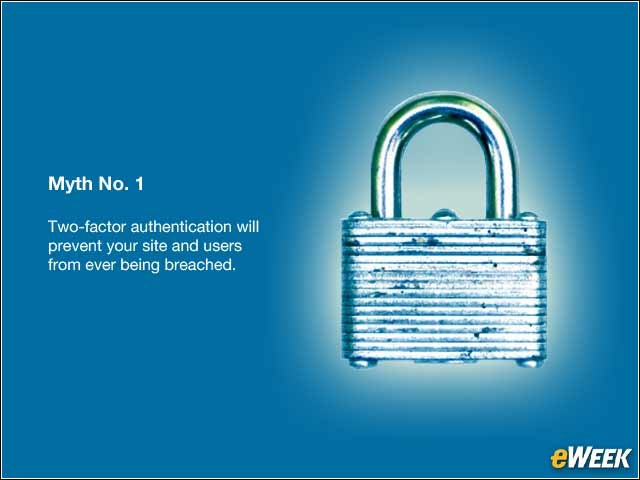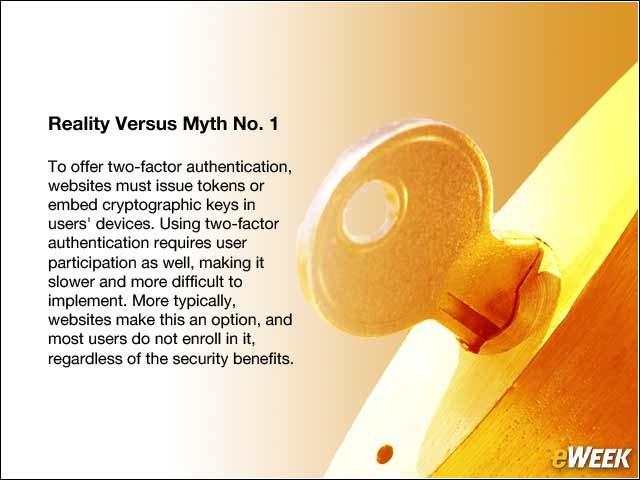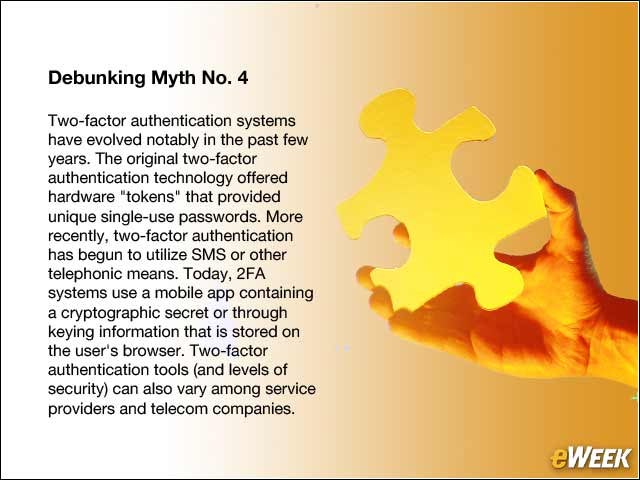eWEEK content and product recommendations are editorially independent. We may make money when you click on links to our partners. Learn More.
3Reality Versus Myth No. 1
To offer two-factor authentication, websites must issue tokens or embed cryptographic keys in users’ devices. Using two-factor authentication requires user participation as well, making it slower and more difficult to implement. More typically, websites make this an option, and most users do not enroll in it, regardless of the security benefits.
4Myth No. 2
5Debunking Myth No. 2
Nothing is completely secure on the web. While most of today’s 2FA implementations do improve security, many still have significant vulnerabilities. With token-based 2FA, the level of security of the issuer or manufacturer of third-party authentication can also vary and are typically unknown unless there is a security beach, much like the March 2011 breach of RSA SecurID tokens. With SMS-based 2FA (the most common 2FA deployed today), the security can vary with each mobile provider and can be vulnerable when changes take place, such as switching mobile phone numbers. Cyber criminals can also install malware on mobile devices that can intercept text messages containing the two-factor authentication code.
7Debunking Myth No. 3
Mobile devices are able to easily authenticate users with both keying information behind the scenes plus a memorized factor on the same devices. Two-factor authentication can be deployed in devices that have the ability to store keying information. An app can use that keying information in conjunction with something the user knows to prove both possession of the device and knowledge of the memorized secret. An app can then prompt the user for information and use cryptographic techniques to prove that the user was in possession of the cryptographic key and knew the memorized factor without the need for those secrets to ever leave the user’s device.
8Myth No. 4
9Debunking Myth No. 4
Two-factor authentication systems have evolved notably in the past few years. The original two-factor authentication technology offered hardware “tokens” that provided unique single-use passwords. More recently, two-factor authentication has begun to utilize SMS or other telephonic means. Today, 2FA systems use a mobile app containing a cryptographic secret or through keying information that is stored on the user’s browser. Two-factor authentication tools (and levels of security) can also vary among service providers and telecom companies.
10Myth No. 5
11Debunking Myth No. 5
Some companies only offer two-factor authentication because it is required of them. The solutions that these companies use, such as browser fingerprinting, could barely qualify as legitimate 2FA applications to meet their compliance requirements. This is due to the fact that many IT managers don’t understand how two-factor authentication can reduce fraud and want to minimize the effort for their users. An approach they should be utilizing is one that offers a flexible authentication mechanism that gives users the convenience of a single-factor authentication for lower risk operations. This is convenient for users with the added benefit of reducing fraud.










